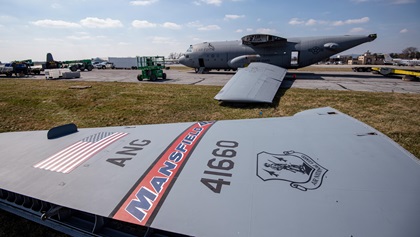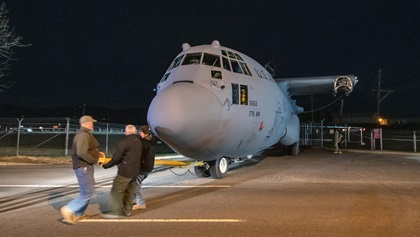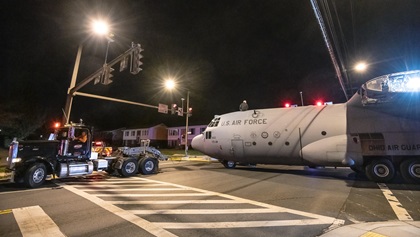End of the line
Air Force C–130 makes final trip—by road
It’s not very often that you hear the command, “Pull chocks,” on a city street, miles from the nearest airport. But the phrase was shouted several times in the early morning hours March 14, as a retired U.S. Air Force C–130H Hercules was pulled—on its own wheels—some 7.5 miles through the streets and highways of Frederick, Maryland, to its final assignment.
The four-engine Air Force turboprop transport, built in 1974, was flown into Frederick Municipal Airport in September 2019. Over the past six months it had become a fixture at the busy general aviation airport that is the home of AOPA.
Finally it was towed away in the wee hours to its final assignment, with the Air Force Medical Evaluation Support Activity (AFMESA), which operates a testing facility on Fort Detrick—a U.S. Army Medical Command garrison on the west side of Frederick that plays a key role in biological research. AFMESA’s mission, testing medical technology and devices to ensure they meet the military’s needs and can survive the rigors of deployment, is unique within the U.S. military. The AFMESA testing site already includes a complete 10-bed Expeditionary Medical Support Hospital, a 44,000-square-foot test pad, and other testing facilities that simulate many of the conditions medical airmen experience in the field.

At AFMESA the Hercules will be reassembled, except for its engines and propellers, and used to test equipment and procedures. A speaker system will be installed to replicate the sounds usually experienced in a C–130, both in flight and on the ground.
But first it had to get there. The move followed a circuitous route that had been carefully evaluated to ensure sufficient height clearance between the fuselage and overhead obstructions and was scheduled to begin at 2 a.m. to minimize traffic disruptions.
This move was unusual because the airplane was being towed on its own wheels, explained Charles White of moving contractor Whites Aircraft Salvage and Parts. He has moved and dismantled many large aircraft, including more than 40 C–130s, some of which have been repurposed to train paratroopers or loadmasters. “It’s good to reuse them,” he said, adding that in this case the relatively short distance and clearance issues made towing the Hercules practical.

White got into the aircraft transport and salvage business by accident. “About six weeks into retirement I realized this is what I want to do,” he said of the chapter in his life that will soon close. “I’m retiring at the end of the year and turning the company over to Tom Stone,” he said. “At 74 I’m ready to go fishing.”
Connecting a safety chain caused a slight delay but the C–130 was rolling by 2:25 a.m. Slowing down for tight clearances, the aircraft traveled as fast as 10 to 20 mph on open stretches of road. About 4:15 a.m. the caravan—a truck tractor pulling the Hercules with a towbar, several trucks and trailers with additional crew and support equipment, and a Maryland State Police escort—reached a very tight, descending exit ramp from U.S. Route 15 South to Rosemont Avenue. It had been identified as the most challenging segment of the journey for the 97-foot-9-inch-long fuselage, and White and some of his crew walked the ramp again the day before the move. Navigating this short stretch of road took an hour and a half. During the descent the towbar detached from the truck and had to be reattached.

A second truck was connected to the rear of the airplane with safety chains to provide stopping power, and White had two people in the aircraft itself—one person in the pilot’s seat to apply the brakes if necessary, and an observer riding in the roof hatch to monitor clearances. Only enough hydraulic pressure remained in the system to apply the brakes six times, White noted. Especially on the steep grade, chocks were used to ensure the Hercules didn’t move unintentionally. It was apparent that White has moved many of the big transports.
About 5:46 a.m. the caravan reached the Montevue Lane gate to Fort Detrick’s Area B, where AFMESA is located. There, the movers reconfigured to pull the Hercules backward onto the base, so it could more easily be positioned in its final parking spot. To steer the hulking airplane through the narrow gate, crew manhandled the heavy towbar. The transport rolled onto the Army installation at 6:27 a.m.

The C–130H logged more than 24,000 flight hours and had most recently served with the Ohio Air National Guard, based at Mansfield Lahm Regional Airport in Mansfield, Ohio. It was named Spirit of Clear Fork Valley, honoring an area of southern Richland County, Ohio, that is home to a number of members of its previous unit, the 179th Airlift Wing. However, it’s not the first C–130 to wear that name.
On October 16, 2014, Jenny Carr—wife of then-Butler, Ohio, Mayor Kevin Carr—revealed the script tribute over the crew door. But that aircraft carried the serial number 81-0629, and by summer of 2019 that aircraft apparently had been transferred to the 189th Airlift Wing in Little Rock, Arkansas, where it serves as the wing commander’s flagship aircraft. The aircraft delivered to Maryland for the AFMESA assignment—and now named Spirit of Clear Fork Valley—is 74-1660 which, interestingly, carried in its cockpit a set of custom reflective cockpit window covers made by industry supplier Bruce's Custom Covers embroidered with ship number 629, reflecting the original Spirit of Clear Fork Valley.
Little history of C–130H 74-1660 was available from project managers, but information available online revealed that it was assigned to Yokota Air Base in Japan, and that its duties took it to locations including Hazrat Shahjalal International Airport in Dhaka, Bangladesh, and Ben Gurion Airport near Lod, Israel.
Watch the disassembly process unfold in this time-lapse video:











